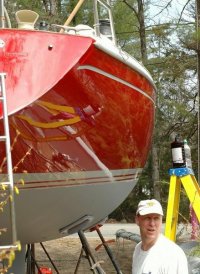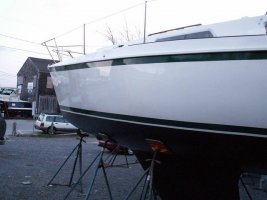Part 2
OK some more tips.
Tips for keeping it clean after you've reconditioned it:
1) With two coats of a Colinite paste carnuba on the hull I only wash the boat with IMAR brand boat wash! This stuff is great and it's safe for washing Strattaglass dodger windows too. The reason I use it is because it's the only product I've found that cleans but does not break down the wax. I'm still beading after 7 months! Do NOT use a soap with a built in wax or one that's a heavy detergent or you will eat away and ruin your protective wax barrier. You can order IMAR products from Defender or directly from the IMAR web site, although, Defender is cheaper. Using this soap and a very soft car wash brush on a stick works well and does not ruin your wax.
Tips for "yellow" looking hulls:
2) Before waxing/buffing: If your hull is old and dirty buy a cheap rain suit, duck tape, rubber gloves and some ON/OFF (basically acid). Duck tape around your wrists so you don't get acid on you while reaching over head to wash the boat. Wait until a nice rainy day and wash the entire hull with ON/OFF. Buy a roll of plastic and rip it with a razor knife into 12-inch wide lengths. Tape this to the water line with 3M green tape (seems to work) at the top but let it hang on the bottom as a drip edge skirt. You do this so the ON/OFF does not eat the copper bottom paint and can drip on the ground vs. the bottom. Wash and rinse quickly a small area at a time and do this preferably before you before you bottom paint just in case. On/Off is basically FSR without the gel. However you can wash much faster with ON/OFF than you can with FSR. The ON/OFF will bring back the white of the hull by removing the metals or tannins (that rusty orange discoloration you get) that attach to the gel coat from the ocean. Maine has lots of metals in the water and ON/OFF is an acid that will eat it. You'll be amazed at the difference in the color of your hull. This is a good place to start before waxing if your boat is older than a few years. Be careful not to get On/Off or FSR on aluminum rub rails, cleats etc. because it will pit them. You could also use FSR but it will take a full day to do it right vs. 1/2 hour for the skirt set up and 1/2 hour washing.
Tips for applying the wax:
3) Do I apply the wax by hand? Yes! DO NOT apply or remove the wax phase with the buffer! I use the 4-inch round Meguiars foam applicators you can buy at an auto parts store and a spray/mist bottle of water, like you use for ironing. The spray bottle is the secret trick for applying a true Carnuba wax. Simply mist the hull and liberally apply the wax. Wait for it to dry and buff by hand with a Micro Fiber rag. Do not use terry cloth! Once you use a Micro Fiber detailing cloth for waxing you'll wonder how you ever survived without one! The spray of water some how helps it attach and buff out to a harder, shinier easier to wipe off finish. It's sort of like when you get your shoes polished and the guy hits them with a mist bottle and then buffs the shine up. I don't think this trick works with the polymer/Carnuba blends like the 3M paste but it's like gold with the Collinite Carnuba as well as Tre-Wax. Another trick is not to wax a large area! Do a three foot wide swath from toe rail to waterline marking where your are waxing at the toe rail with a piece of blue tape. Also leave a little residue on the leading edge so you'll know exactly where to start. You'll wipe this leading edge when finished with the next swath leaving another leading edge to go off of.
I have tried using my buffer to remove the wax but the friction heat is bad for it and it does not shine as well or last as long! Buffing it off by hand gives it a harder shell because it's cooler and does not re-melt the curing wax. Have plenty of fresh Micro Fiber rags for the wipe off! On my 31 footer I use only four Micro's where it used to take about a dozen terry cloth rags. I buy my Micro Fiber rags at Sam's Club or Wal*Mart. Try and find the best quality Micro*Fiber you can it WILL make a difference. Sometimes the quality of the Sam's Club Micro's is poor so I go to Wally World. You want the ones that sell individually or three to a pack not the 12 to a pack rags as the quality is bad on the big multi packs! I think you get 3 for between 6 to 8 dollars. Most all auto parts stores also sell Micro Fiber detailing rags!
Tips for decks:
4) I buff the smooth and the non-skid. I use Collinite there as well and it does not seem to make my decks slippery like a Teflon or polymer wax does. You could also tape off the non-skid and buff the white only letting the non-skid flatten out. I did this on one boat and it looked great!
I hope this info helps and is useful to some. If you do it be prepared to commit the time and increase the value of your boat as well!!!! Trust me it pays back. I've never sold any boat I've owned for less than I paid for it including the fact that I pay a 10% commission...
The picture does not do it justice but look at the reflection in the gel-coat and the detail in the reflection. Less distortion in the reflection shows a very good polish/glaze with virtually no swirl marks. Picture:
Link submitted by author
More info on pads, compounds and rags:
Here is link to a photo showing some of the products I use:
Link submitted by author
As maintaining the buffing pads I wash them alone on COLD with regular detergent in a home washing machine. Sometimes it may take two cycles to get them clean. DO NOT dry them in a dryer and don't wash them on hot they are wool and a hot wash or dry will literally change the pad grade. A polish grade pad can become a compound pad fairly quickly so wash cold then air dry. I rarely have to clean a pad, during a buffing project, unless I'm doing a friends boat that is badly oxidized. Use slow speeds and light pressure to prevent compound burning. You can also use a mist bottle of water, very sparingly, to give a little moisture to the hull and lube the pad. This however will create more sling so you’re best to go slow and keep the compound wet. The secret is to keep the pad "wet" if it dries, it burns, and you'll need a "spur wheel" or spigot wash to field clean it. Spurs are available at an autobody supply shop or auto parts store.
Another trick I use for a field clean is to remove the pad from the buffer and rinse it under a boatyard spigot scrubbing it with my fingers till it's clean. I then re-install the pad on the buffer and spin it on the buffers highest speed inside a 5-gallon bucket to catch the sling. Spin it until no more water spins off on the inside of the bucket. Once done with that use a towel to get it as close to dry as possible. This is the method I use as I feel it's more thorough than a spur.
A word of caution about "cheap" compounds and polishes is that they may contain silicone or wax or oils, which will not come, clean of the pads and will eventually ruin them. Use 3M products or Meguiars but carefully read the labels to make sure it says, "does not contain silicone". Many of the cheap products from both 3M and Meguiars contain silicone. Finesse It does not contain any silicone but be sure to read all labels. The cheap compounds use silicones because it adds lubricity to the wheel/pad, for novice users, but a low speed and a light touch will get you a lot further than a polishing/compounding product containing waxes or silicones. Compounding and polishing is just that compounding and polishing not compound and wax or polish and wax at the same time.
Think of a compound or polish as a very, very, very fine grit liquid sandpaper. As you know wet sandpaper contains no silicones or "essential oils" so neither should a compound or polish. Products containing silicones or "essential oils" give you a false sense of shine. This forces you to stop polishing well before you have actually finished shining. The hull should be perfectly shiny before the wax goes on but not shiny from silicone or oils. These additives wash off quickly and also prevent the Carnuba wax from binding properly to the hull. If a product says "paintable" it does not contain silicone!
As for the microfiber rags do NOT use any sort of fabric softener it will ruin the rags and also do not dry them in a dryer. You can wash them on warm or hot though... Keep me in the loop!!
Products I use containing NO SILICONE:
3M Marine Super Rubbing Compound
3M Finesse It - Polish
Meguiars #9 Swirl Remover - Fine Polish (in the tan bottle pro-series not marine grade in the blue bottle)
Meguiars #7 Show Car Glaze - Ultra fine Polish also pro-grade in a tan bottle.
Collinite #885 Fleet Wax - Paste Version




